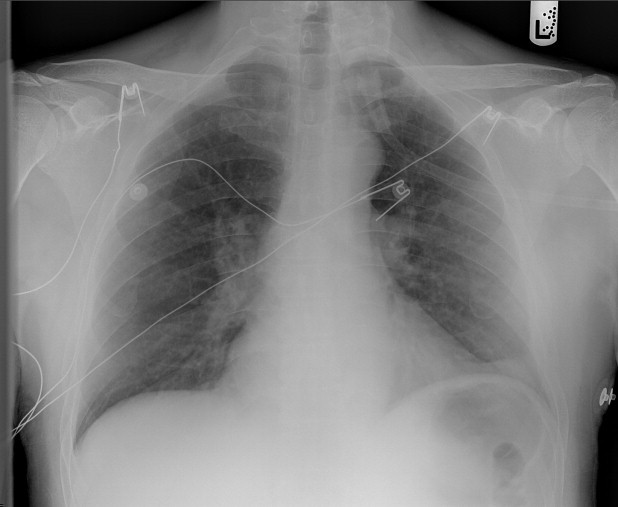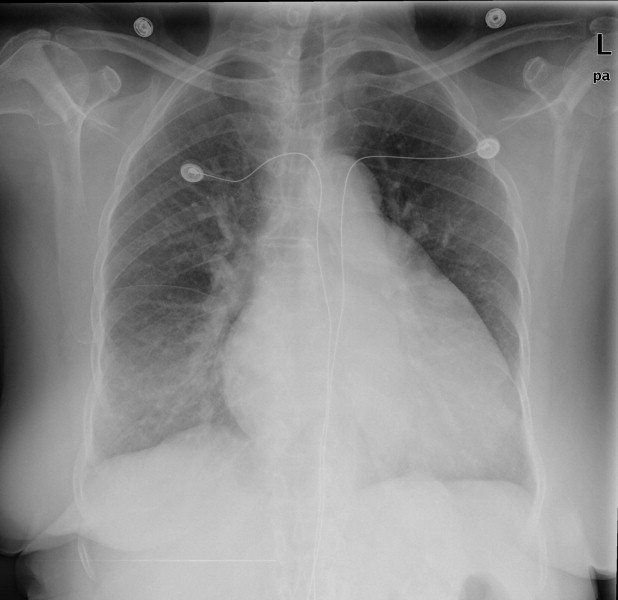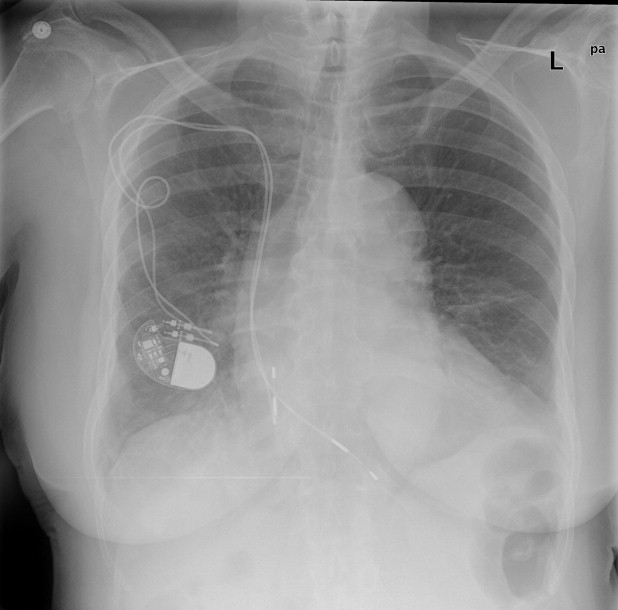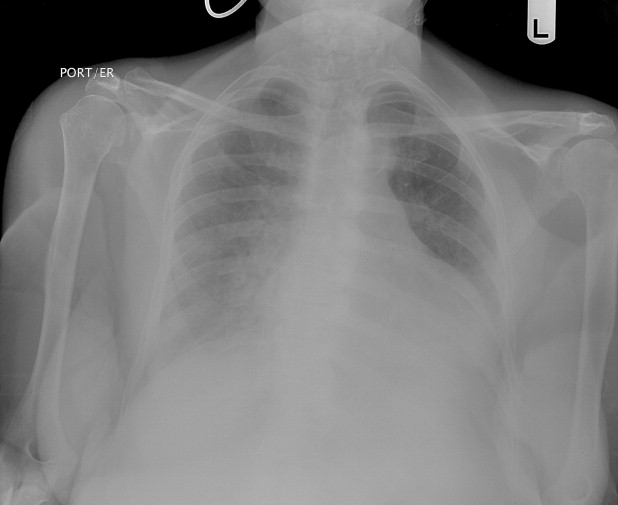Rationale and Objectives
This study was designed to evaluate the performance of radiology residents in interpreting emergency department (ED) chest radiographs for congestive heart failure and to characterize the factors associated with a subsequent amended interpretation by an attending radiologist.
Materials and Methods
We retrospectively reviewed all amended reports for ED chest radiographs between January 2004 and July 2005 and identified those with discrepant interpretations regarding the diagnosis of congestive heart failure. A total of 1.9% (476 of 24,600) of chest radiographs were amended over the study period. Forty-eight patients (75% female, mean age 66 years) whose chest radiograph was amended for the diagnosis of congestive heart failure and were available for review formed the study population. A control group of 35 patients (69% female, mean age 67 years) were individually matched to a convenience subset of patients by age, gender, clinical indication, and radiographic projection. Chest radiographs were in the anteroposterior projection in 62% (30 of 48) of study patients and 60% (21 of 35) of controls. A blinded expert panel of three board-certified cardiothoracic radiologists jointly reviewed each chest radiograph for the presence or absence of congestive heart failure and its specific radiographic findings.
Results
The expert panel diagnosed congestive heart failure in 19% (9 of 48) of study patients and in 23% (8 of 35) of controls ( P = .65). When present, congestive heart failure was mild to moderate in severity in both the study and control groups ( P = 1.00). There was a significant difference in the expert panel agreement between the attending versus the resident interpretation (65% versus 35%, P = .008), for the study group. This resulted in fair agreement (κ = 0.29) between the expert panel and the attending interpretation and no agreement (κ = −0.29) between the expert panel and the resident interpretation. In contrast, the expert panel agreed with the joint resident/attending interpretation in 83% (29 of 35) of controls, yielding substantial agreement (κ = 0.72).
Conclusion
Interpretation of chest radiographs for congestive heart failure by radiology residents has a low error rate. The majority of chest radiographs with discrepant resident and attending interpretations were portable films of female patients with subtle radiographic findings of congestive heart failure, and were inherently difficult to interpret.
With a prevalence of 1% to 2% and an incidence of 400,000 persons per year, the ubiquity of congestive heart failure in the United States is alarming. Despite advances in diagnosis and treatment, the median survival of slightly greater than 3 years for men and 5 years for women is unchanged from that of the early 1970s. One third of patients with congestive heart failure are hospitalized every year, making it the leading diagnosis-related group in patients over 65 years of age and the single greatest cost to the Centers for Medicare and Medicaid Services (CMS) ( ). This high hospitalization rate may be partially explained by the recidivist nature of congestive heart failure, which prompts a high frequency of emergency department (ED) visits ( ).
The presenting signs and symptoms of congestive heart failure are well characterized. Unfortunately, each sign or symptom alone provides inadequate sensitivity or specificity, and the most common presenting symptom in the ED, dyspnea, is nonspecific ( ). Validated clinical and radiographic scores, such as the Framingham Criteria and Boston Criteria, are useful in diagnosing congestive heart failure ( ). Relatively recently, a biochemical marker, brain natriuretic peptide (BNP) and its precursor, Pro-BNP, also proved helpful in identifying the presence of congestive heart failure ( ). This biochemical marker, when added to certain clinical and radiographic findings, demonstrates enhanced diagnostic ability ( ).
Get Radiology Tree app to read full this article<
Get Radiology Tree app to read full this article<
Get Radiology Tree app to read full this article<
Materials and methods
Get Radiology Tree app to read full this article<
Get Radiology Tree app to read full this article<
Get Radiology Tree app to read full this article<
Get Radiology Tree app to read full this article<
Table 1
Chest Radiograph and Patient Characteristics
Study Group (n = 48) Controls (n = 35)P Value Gender, n (%) Male 14 (29) 11 (31) .82 Female 34 (71) 24 (69) .82 Age, mean (SD), yr 65.7 (17.9) 66.9 (12.7) .72 Film projection(s), n (%) Posteroanterior and lateral 18 (38) 14 (40) .82 Anteroposterior 30 (62) 21 (60) .82 Resident experience/year, n (%) PGY-II 9 (19) 4 (11) .37 PGY-III 34 (71) 18 (51) .07 PGY-IV 5 (10) 13 (37) .004 † Mean resident PGY level (SD) 2.92 (0.54) 3.26 (0.66) .02 † Positive resident CHF diagnoses (%) 24 (50) 12 (34) ‡ .15 Positive attending CHF diagnoses 24 (50) 12 (34) ‡ .15 Positive panel CHF diagnoses 9 (19) 8 (23) .65
*Percentages are rounded and may not add up to 100%.
Get Radiology Tree app to read full this article<
Get Radiology Tree app to read full this article<
Get Radiology Tree app to read full this article<
Get Radiology Tree app to read full this article<
Get Radiology Tree app to read full this article<
Statistical Analysis
Get Radiology Tree app to read full this article<
Get Radiology Tree app to read full this article<
Results
Get Radiology Tree app to read full this article<
Table 2
Characteristics of Congestive Heart Failure for Study and Control Groups as Described by the Expert Panel
Characteristic, n (%) Study Group (n = 9) Controls (n = 8)P Value Cephalization 7 (78) 8 (100) .47 Kerley B-lines 2 (22) 0 (0) .47 Bronchial wall thickening 1 (11) 0 (0) 1.00 Hilar haziness 3 (33) 3 (38) 1.00 Diffuse increase in lung density 3 (33) 1 (12) .58 Airspace opacities 0 0 1.00 Pleural effusion 6 (67) 5 (63) 1.00 Cardiomegaly 5 (56) 4 (50) 1.00
Get Radiology Tree app to read full this article<
Get Radiology Tree app to read full this article<
Get Radiology Tree app to read full this article<
Get Radiology Tree app to read full this article<
Get Radiology Tree app to read full this article<
Get Radiology Tree app to read full this article<
Table 3
Expert Panel, Preliminary Resident, and Staff Radiologist Agreement
Expert Panel Agreement Resident Attending_P_ Value Study group 17/48 (35%) 31/48 (65%) .008
Table 4
Expert Panel, Preliminary Resident, and Staff Radiologist Interrater Reliability
Study Group Control Group Resident Versus Expert Panel Attending Versus Expert Panel Attending/Resident Versus Expert Panel Unweighted κ value (95% CI) −0.29 (−0.79 to 0.21) 0.29 (0.02 to 0.56) 0.72 (0.47 to 0.98)
Get Radiology Tree app to read full this article<
Discussion
Get Radiology Tree app to read full this article<
Get Radiology Tree app to read full this article<
Get Radiology Tree app to read full this article<
Get Radiology Tree app to read full this article<
Get Radiology Tree app to read full this article<
Get Radiology Tree app to read full this article<
Get Radiology Tree app to read full this article<
Get Radiology Tree app to read full this article<
Get Radiology Tree app to read full this article<
Get Radiology Tree app to read full this article<
References
1. Grossman S., Brown D.F.M.: Congestive heart failure and pulmonary edema.2006. Available at http://www.emedicine.com/EMERG/topic108.htm .
2. Shamsham F., Mitchell J.: Essentials of the diagnosis of heart failure. Am Fam Physician 2000; 61: pp. 1319-1328.
3. CMS 2001 inpatient discharge data base: MED-PAR, DRG 427.
4. Peacock W.F.: Using the emergency department clinical decision unit for acute decompensated heart failure. Cardiol Clin 2005; 23: pp. 569-588.
5. Marantz P.R., Tobin J.N., Wassertheil-Smoller S., et. al.: The relationship between left ventricular systolic dysfunction and congestive heart failure diagnosed by clinical criteria. Circulation 1988; 77: pp. 607-612.
6. Gluecker T., Capasso P., Schnyder P., et. al.: Clinical and radiologic features of pulmonary edema. Radiographics 1999; 19: pp. 1507-1531.
7. Mueller C., Laule-Kilian K., Frana B., et. al.: Use of B-type natriuretic peptide in the management of acute dyspnea in patients with pulmonary disease. Am Heart J 2006; 151: pp. 271-277.
8. Baggish A.L., Siebert U., Lainchbury J.G., et. al.: A validated clinical and biochemical score for the diagnosis of acute heart failure: The ProBNP investigation of dyspnea in the emergancy department acute heart failure scopre. Am Heart J 2006; 151: pp. 48-54.
9. Mueller-Lenke N., Rudez J., Staub D., et. al.: Use of chest radiology in the emergency diagnosis of acute congestive heart failure. Heart 2006; 92: pp. 695-696.
10. Collins S.P., Lindsell C.J., Storrow A.B., Abraham W.T.: Prevalence of negative chest radiography results in the emergency department patient with decompensated heart failure. Ann Emerg Med 2006; 47: pp. 13-18.
11. White C.S., Davis S.D., Aquino S.L., et. al.: Expert Panel on Thoracic Imaging: Congestive heart failure.2006.Ameican College of RadiologyReston, VA In press
12. Singh V.: Congestive heart failure.2006. Available at http://www.emedicine.com/radio/topic189.htm .
13. Nathanson N.: Emergency radiology credentialing examination: 4 Year experience. Emerg Radiol 1995; 2: pp. 245-247.
14. Pistolesi M., Miniatti M., Milne E.N.C., Giuntini C.: The chest roentgenogram in pulmonary edema. Clin Chest Med 1985; 6: pp. 215-341.
15. Herman P.G., Kahn A., Kallman C.E., et. al.: Limited correlation of left ventricular end-diastolic pressure with radiographic assessment of pulmonary hemodynamics. Radiology 1990; 174: pp. 721-724.
16. Ojutiku O., Haramati L.B., Rakoff S., Sprayregen S.: Radiology residents’ on-call interpretation of chest radiographs for pneumonia. Acad Radiol 2005; 12: pp. 658-664.
17. Tudor G.R., Finlay D., Taub N.: An assessment of inter-observer agreement and accuracy when reporting plain radiographs. Clin Radiol 1997; 52: pp. 235-238.
18. Carney E., Kempf J., DeCarvalho , et. al.: Preliminary interpretations of after-hours CT and sonography by radiology residents versus final interpretations by body imaging radiologists at a level 1 trauma center. AJR Am J Roentgenol 2003; 181: pp. 367-373.
19. Wysoki M.G., Nassar C.J., Koenigsberg R.A., et. al.: Head trauma: CT scan interpretation by radiology residents versus staff radiologists. Radiology 1998; 208: pp. 125-128.
20. Lowe L.H., Draud K.S., Hernanz-Schulman M., et. al.: Nonenhanced limited CT in children suspected of having appendicitis: Prospective comparison of attending and resident interpretations. Radiology 2001; 221: pp. 755-759.
21. Lal R.L., Murray U.M., Eldevik O.P., et. al.: Clinical consequences of misinterpretations of neuroradiologic CT scans by on-call radiology residents. Am J Neuroradiol 2000; 21: pp. 124-129.
22. Ginsberg M.S., King V., Panicek D.M.: Comparison of interpretations of CT angiograms in the evaluation of suspected pulmonary mbolism by on-call radiology fellows and subsequently by radiology faculty. AJR Am J Roentgenol 2004; 182: pp. 61-66.
23. Wechsler R.J., Spettell C.M., Kurtz A.B., et. al.: Effects of training and experience in interpretation of emergency body CT scans. Radiology 1996; 199: pp. 717-720.
24. Herman P.G., Hessel S.J.: Accuracy and its relationship to experience in the interpretation of chest radiographs. Invest Radiol 1975; 10: pp. 62-67.
25. Velmahos G.C., Fili C., Vassiliu P., Nicolau N., Radin R., Wilcox A.: Around-the clock attending radiology coverage is essential to avoid mistakes in the care of trauma patients. Am Surg 2001; 67: pp. 1175-1177.



